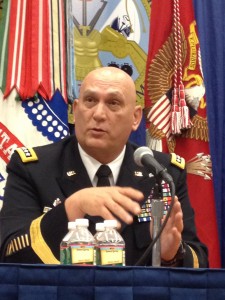Odierno talks technology
The Army’s chief of staff enjoys challenging the technological status quo.
Ask Gen. Raymond Odierno about radios and he gushes over the capabilities of "iPhones," a term he uses generically for smartphones. Ask him about the controversy over Palantir’s link analysis software, and he says the Army might yet figure out how to include it in the service’s intelligence production and sharing toolbox.
Adding the Palantir software to the Distributed Common Ground System-Army would be a big breakthrough for the Palo Alto company. The Palantir software is popular among analysts outside the Army as an easy way to visualize the linkages among terror suspects or criminals.
The Army has tested the software in the lab and in Afghanistan with good results but has resisted embracing it in the DCGS-A network for reasons other than the software's performance. The Army says Palantir's unique design makes it hard to ingest or share data created by non-Palantir software. For two years, Palantir has sought to shoehorn the software into DCGS-A by appealing to Congress and to the media via proxies.
The Army wants all new software to follow a guide called DI2E, short for the Defense Intelligence Information Enterprise, which is the equivalent of a building code book for software developers.
“Right now, there’s some proprietary issues with Palantir. We’re working those now,” Odierno said after a press briefing at the Army Association’s annual conference in Washington, D.C.
At the same time, he warned against hyping the significance of whether or not Palantir’s software is added to DCGS-A:
“What I got frustrated over is -- it’s not DCGS versus Palantir. DCGS-A is much larger than what Palantir is delivering,” he said.
Odierno also defended the performance of DCGS-A: “It’s a huge network, which I think is very, very good.”
As for the smartphones, Odierno said getting more of them into the hands of soldiers could help commanders understand events in the field in close to real time.
“One of our weaknesses now (is) we have all these sensors out there -- squads of people who have information, and when they report it up, it takes a very long time. With these iPhones, it can almost be done instantaneously,” he said.



